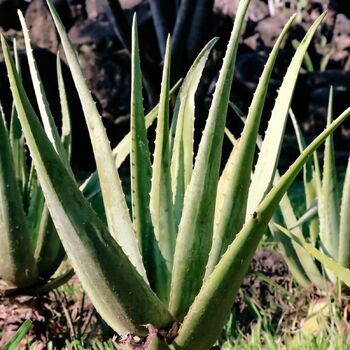
How to Grow Aloe Vera Plants
Grow Guide #2845
Family: Asphodelaceae
Binomial name: Aloe barbadensis
Life Cycle: perennial
This 'How to Grow' guide details everything a home gardener needs to know to plant, grow and care for Aloe vera (Aloe barbadensis).
When to Plant Aloe Vera
Aloe vera is a perennial plant that grows year round in most climates. Use the table below to identify the best time of year to plant aloes in your climate.
| JAN | FEB | MAR | APR | MAY | JUN | JUL | AUG | SEP | OCT | NOV | DEC | |
|---|---|---|---|---|---|---|---|---|---|---|---|---|
| Cool | ||||||||||||
| Temperate | ||||||||||||
| Sub-Tropical | ||||||||||||
| Tropical | ||||||||||||
| Arid |
Preparation
Aloe vera plants are best grown in full sun or part shade. Choose a location that will receive at least 3 hours of full sun each day. If growing aloe vera indoors, place containers in bright filtered light.
Aloe vera plants are perennial, meaning they live for several years. Choose a permanent position where plants can grow undisturbed by regular digging.
Aloe vera plants need a well drained soil enriched with plenty of organic matter. Prepare soil by weeding it thoroughly, digging it over to loosen it and adding aged animal manure or compost. Keep the area free of weeds until planting. Learn more about preparing soil for planting here.
Aloe vera plants can be grown in containers. If possible choose a variety that’s recommended for container growing. Use a good quality potting mix and make sure your container is large enough for mature plants; a minimum of 10 litres is recommended for aloe vera. During the growing season, keep in mind that container grown plants may need additional fertiliser to encourage healthy growth.
How to Plant Aloe Plants
Aloe vera plants are supplied as bare-rooted plants. Plant as soon as possible after delivery.
Planting in a Container
- Fill a pot with good quality cactus or succulent potting mix.
- Position the plant in the soil so the base of the leaves is at ground level.
- Support cuttings wih small stakes or bamboo canes so they stay upright until they are firmly rooted in the soil.
- Water when planted, then no more than once a week.
Planting in the Garden
- Dig a hole at least four times the width of the root ball to provide ample space for the roots to spread.
- Plant the aloes with the base of their leaves level with or slightly above the soil line.
- Support cuttings wih small stakes or bamboo canes so they stay upright until they are firmly rooted in the soil.
- Water when planted, then no more than once a week, checking the soil for moisture before watering.
Aloe plants will survive occasional light frosts but are not hardy in climates that experience regular frosts.
How to Grow Aloe vera
Aloe vera plants are drought tolerant once established and grow best in soil that is dry and very well drained. Let the soil dry out between watering, and only water when the soil is dry about 10cm below the surface (test this by scratching away a little soil with your finger), even in summer. Water deeply in the early morning or late afternoon. Avoid watering the leaves of plants to avoid fungal diseases. Learn more about watering here.
If soil was well prepared no extra fertiliser should be necessary. In poor soil or to give your plants an extra boost, application of a balanced fertiliser or one formulated for fruit and vegetables can be beneficial:
- Apply slow release fertiliser at the recommended rate when transplanting or when seedlings are 5-10cm tall.
- Apply liquid fertiliser at the recommended rate and frequency while plants are fruiting or flowering.
Deadhead aloe vera flowers regularly during the growing season. Using sharp secateurs or snips cut fading or dead flowers off just above a set of leaves. Removing old flowers regularly will encourage plants to produce more flowers. Learn more about deadheading flowering plants here.
How to Harvest Aloe vera
Aloe vera plants should be ready to harvest in approximately 350 days.
Note: the latex-like, yellow sap of aloe vera, called aloin, can cause skin irritation in some people. Wear gloves while harvesting and handling aloe vera leaves.
Aloe vera plants are ready to harvest when the plant is well secured in the soil and there are several large, thick leaves. Harvest the outer leaves by cutting them at soil level using a clean, sharp knife. Leave at least five leaves at the centre of the plant to support future growth. Alternatively, harvest just the top part of a leaf, leaving the rest on the plant for future use.
After harvesting, place the leaves cut side down in a glass or jar and let the thick yellow sap drain away for 15 to 30 minutes. Rinse leaves. Leaves can then be peeled to expose the gel inside, or the gel can simply be squeezed out of smaller leaves. Freshly harvested aloe vera gel can be used immediately, or the leaves can be wrapped in damp paper towels and sealed in a plastic bag, then stored in the fridge for up to a week for future use. Aloe vera can also be frozen for longer term storage; wrap whole leaves in freezer bags or make gel into ice cubes and freeze.
Common Problems when Growing Aloe vera
Like all plants, aloe vera is susceptible to some pests, diseases and other problems. Below is a list of the most common problems gardeners encounter when growing aloe vera plants:
 Aphids are small (2-4mm long) sap-sucking insects that congregate on the new shoots or the undersides of leaves. They can cause leaves to wilt or become discoloured, and also excrete honeydew which can attract ants and other insect pests. To manage aphids, remove them by spraying with a garden hose, apply a soap or alcohol spray, or encourage predatory insects to your garden. Read more about aphids here.
Aphids are small (2-4mm long) sap-sucking insects that congregate on the new shoots or the undersides of leaves. They can cause leaves to wilt or become discoloured, and also excrete honeydew which can attract ants and other insect pests. To manage aphids, remove them by spraying with a garden hose, apply a soap or alcohol spray, or encourage predatory insects to your garden. Read more about aphids here.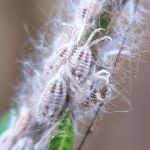 Mealybugs (Pseudococcidae sp.) are small (3-6mm long) sap-sucking insects with white, pink or gray bodies covered in a mealy coating that looks like cotton wool. They can cause leaves to wilt and also excrete honeydew which can attract ants and other insect pests. To manage mealybugs, remove them by wiping leaves, apply a soap or alcohol spray, or encourage predatory insects to your garden. Read more about mealybugs here.
Mealybugs (Pseudococcidae sp.) are small (3-6mm long) sap-sucking insects with white, pink or gray bodies covered in a mealy coating that looks like cotton wool. They can cause leaves to wilt and also excrete honeydew which can attract ants and other insect pests. To manage mealybugs, remove them by wiping leaves, apply a soap or alcohol spray, or encourage predatory insects to your garden. Read more about mealybugs here.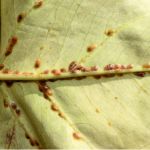 Scale are a diverse group of sap-sucking insects that congregate on the new shoots or the undersides of leaves. They may be hard or soft bodied and brown, orange, grey or white. Scale can damage leaves and also excrete honeydew which can attract ants and other insect pests. To manage scale, brush or hose them off leaves, apply a soap spray, or prune off heavily infested leaves and shoots. Read more about scale here.
Scale are a diverse group of sap-sucking insects that congregate on the new shoots or the undersides of leaves. They may be hard or soft bodied and brown, orange, grey or white. Scale can damage leaves and also excrete honeydew which can attract ants and other insect pests. To manage scale, brush or hose them off leaves, apply a soap spray, or prune off heavily infested leaves and shoots. Read more about scale here.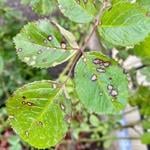 Bacterial leaf spot is a disease that causes irregularly shaped brown spots on all above-ground parts of a plant. The spots at first appear to be wet but become dry and scab-like over time. Leaves and flowers can fall prematurely. Water plants at soil level (not on the leaves), dispose of fallen leaves and fruit and practice crop rotation.
Bacterial leaf spot is a disease that causes irregularly shaped brown spots on all above-ground parts of a plant. The spots at first appear to be wet but become dry and scab-like over time. Leaves and flowers can fall prematurely. Water plants at soil level (not on the leaves), dispose of fallen leaves and fruit and practice crop rotation. Rust (Puccinia sp.) is a fungal disease that causes brown to orange raised spots or patches to appear on foliage. Fungal spores are spread by wind or water to neighbouring plants, especially in temperatures of 10-20C and when humidity is high. To manage rust, space plants to avoid overcrowding, grow them in the recommended amount of light (eg full sun), do not over fertilise crops, remove dead plants and practice crop rotation. Read more about rust fungus here.
Rust (Puccinia sp.) is a fungal disease that causes brown to orange raised spots or patches to appear on foliage. Fungal spores are spread by wind or water to neighbouring plants, especially in temperatures of 10-20C and when humidity is high. To manage rust, space plants to avoid overcrowding, grow them in the recommended amount of light (eg full sun), do not over fertilise crops, remove dead plants and practice crop rotation. Read more about rust fungus here.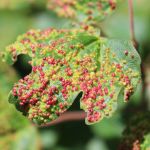 Gall mites (Eriophyid mites) are microscopic, air-borne pests that cause distorted and abnormal growth when they feed on plants. Symptoms include bumpy or blistered foliage, excess growth of shoots, thick leaves or large, abnormal buds and flowers. Some gall species are harmless while others are damaging or fatal. Correct identification is important. Identify which type of gall is present; dispose of plants with infestations of damaging gall, including aloe gall.
Gall mites (Eriophyid mites) are microscopic, air-borne pests that cause distorted and abnormal growth when they feed on plants. Symptoms include bumpy or blistered foliage, excess growth of shoots, thick leaves or large, abnormal buds and flowers. Some gall species are harmless while others are damaging or fatal. Correct identification is important. Identify which type of gall is present; dispose of plants with infestations of damaging gall, including aloe gall. Root rot is a disease caused by soil-borne fungi found in wet soil. Plants may be slow to establish, have yellowing or wilted foliage and have soft, brown tissue around the base of the stem and roots. Root rot is often fatal; remove and dispose of affected plants. Reducing soil moisture, adding organic matter to the soil and making sure mulch doesn't touch the stems of plants may help avoid root rot.
Root rot is a disease caused by soil-borne fungi found in wet soil. Plants may be slow to establish, have yellowing or wilted foliage and have soft, brown tissue around the base of the stem and roots. Root rot is often fatal; remove and dispose of affected plants. Reducing soil moisture, adding organic matter to the soil and making sure mulch doesn't touch the stems of plants may help avoid root rot.


.png)



